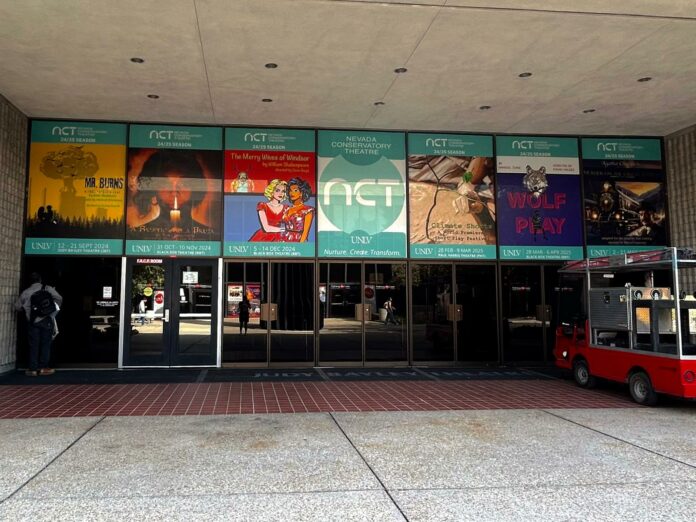A dirty orange loveseat, a lawn chair, a beach rocking chair and a fire pit welcome the audience to “Mr. Burns, A Post-Electric Play.” It’s lifted above the orchestra pit to match the height of the stage as the theater plays “a mix of inspirations of ‘The Simpsons’ theme music,” according to director Kirsten Brandt.
The setup for the show is amazing in all ways possible. It prepares the audience for the dark comedy they are about to experience, and at 7:30 p.m., Brandt comes out to welcome the first audience of “Mr. Burns.” At 7:35 p.m. on Sept. 11, the audience was thrusted into remembering the “Cape Feare” episode of “The Simpsons” with the cast. Andrew Mikhael Caleb Trevino opened the show with energy that drew you into it, as confusing as it may be at first glance.
The entire cast showed off their use of the Suzuki method throughout the first act. A memorable performance was Kate Critchfield, who stayed low to the ground as if ready to leap away from danger at any moment like an animal would. However, the most memorable moment of the first act is when we meet Andrew Scott Bullard’s character, Sam. The characters all share their “10 names” with him to see if he has seen any of their loved ones, whom they can’t contact due to a nuclear explosion shutting down the grid. The actors gave a wonderful performance, ranging from hopeful or almost indifferent to being helpless and scared for their loved ones. These emotions are relatable, and I commend JoAnn Birt for bringing the first moment of helplessness to the audience. The entire first act shows the audience what community after tragedy looks like and how people cope with what they have experienced.
The second act is set seven years later, where the audience follows the group, plus a new member, rehearsing for their performance of “Cape Feare,” with commercials (that they also perform) in between. Between songs, scenes, commercials and arguments, the audience gets a firsthand look at how their world is now running. They converse about how people are trading lithium batteries for Diet Coke and how they still don’t know the implications of the nuclear event that caused the grid to go down. We follow the cast through the different issues they’re facing, whether it’s fear of the unknown or fear of how other people are getting bolder when it comes to scamming the group out of their earnings.
During intermission, Mark Siparro, a UNLV student, believed the show was “very captivating to the eye… it’s a captivating performance.” His friends agreed that, while they were initially confused by what the show was about, the more it went on, the more “captivated” they became. UNLV student Tiana Torres said that she “loved when they sang all the different songs; it was like Pitch Perfect,” but they were also initially confused at the beginning of the show.
The third act is set 75 years later and is performed by the cast and a chorus. The original performance of “Cape Feare” the cast was performing has now become legend and almost a cautionary tale. The last act serves as an allegory for how people may have lost everything in the nuclear explosions but have learned to continue on and find hope. The allegory is told through a Greek chorus and a retelling of the “Cape Feare” episode with some changes. The final act is a tear-jerker and a gasp-stealer. It also showcased the talent of the main cast. The show overall demonstrates this, but the last act is especially poignant.
This show was important to bring to UNLV, not only as something fun for students but for its societal meaning. The show teaches the audience that when you are a survivor of a tragedy and you have no one with you, you find people. You create community, and you continue to hope, learn and live. As a community, you bond over past experiences and media that you have shared. Stories leave trails and communities behind them, and “Mr. Burns” shows how they are passed and how the original cast, who are most likely dead in the last act, are having their show continue on as a legend. I have seen many shows from the Nevada Conservatory Theatre, but this has been hands down the best one so far. I applaud the cast, chorus, creative team and especially the director for bringing such a fun show with deep meaning to UNLV.
“Mr. Burns, A Post-Electric Play” is playing at the UNLV Performing Arts Center from Sept. 12 to 21.

